Running Effective Project Meetings: Key Types, Strategies, & Tips

Sorry, there were no results found for “”
Sorry, there were no results found for “”
Sorry, there were no results found for “”
Project meetings are a double-edged sword. Anyone who has organized or attended one knows it.
On the one hand—they keep projects on track, ensure alignment among team members, and address roadblocks that may arise through a project’s lifecycle.
On the other, they may descend into unproductive discussions and take time away from execution.
So, how can you make sure your project meetings belong to the first category?
Simple! By reading this blog post. 🤩
We’ll delve into the nuances of project management meetings and equip you with the knowledge and skills to transform them into catalysts for success.
We’ll look at different project meeting types, highlighting their purpose, attendees, and key outcomes, and explore important meetings that every project manager should master.
As a bonus, we’ve also compiled strategies, tips, and templates to boost participation, capture group decisions, and streamline project management meeting preparation.
Let’s begin.
A project meeting is a scheduled time for project teams and other stakeholders to come together, share updates, troubleshoot problems, and make decisions to ensure their projects progress smoothly. 🫱🏾🫲🏽
Project meetings usually have an agenda and involve reviewing action items, KPIs, project health metrics, upcoming milestones, and issues log.
Such meetings provide a forum for communication and collaboration among those involved in a project, which includes team members, project managers, clients, or other interested parties.
The key is to ensure your meetings are focused and productive and contribute to project success.
Let’s take a look at the diverse types of project management meetings and how they can be categorized.
Just as projects vary in their shape, size, and scope, so do project meetings.
A kickoff meeting may be filled with excitement and introductions, while a stakeholder-only meeting focuses on crisp communication and persuasive presentations. The meeting format can also differ: It could be held virtually, in person, in a hybrid format, or it could even be a full-blown conference. Meetings can be regular, recurring appointments or one-off or ad hoc events. Depending on their purpose, meetings can be termed formal or informal.
Recognizing these differences and their unique purposes is the first step toward choosing the right type of project meeting. Most project managers mix and match categories or create new types of events based on specific project needs and preferences.
Such meetings vary in their needs and complexity, and several common categories emerge. Here’s a breakdown.
By carefully selecting the appropriate meeting type, tailoring the meeting agenda, and ensuring active participation, project managers can ensure successful project outcomes.
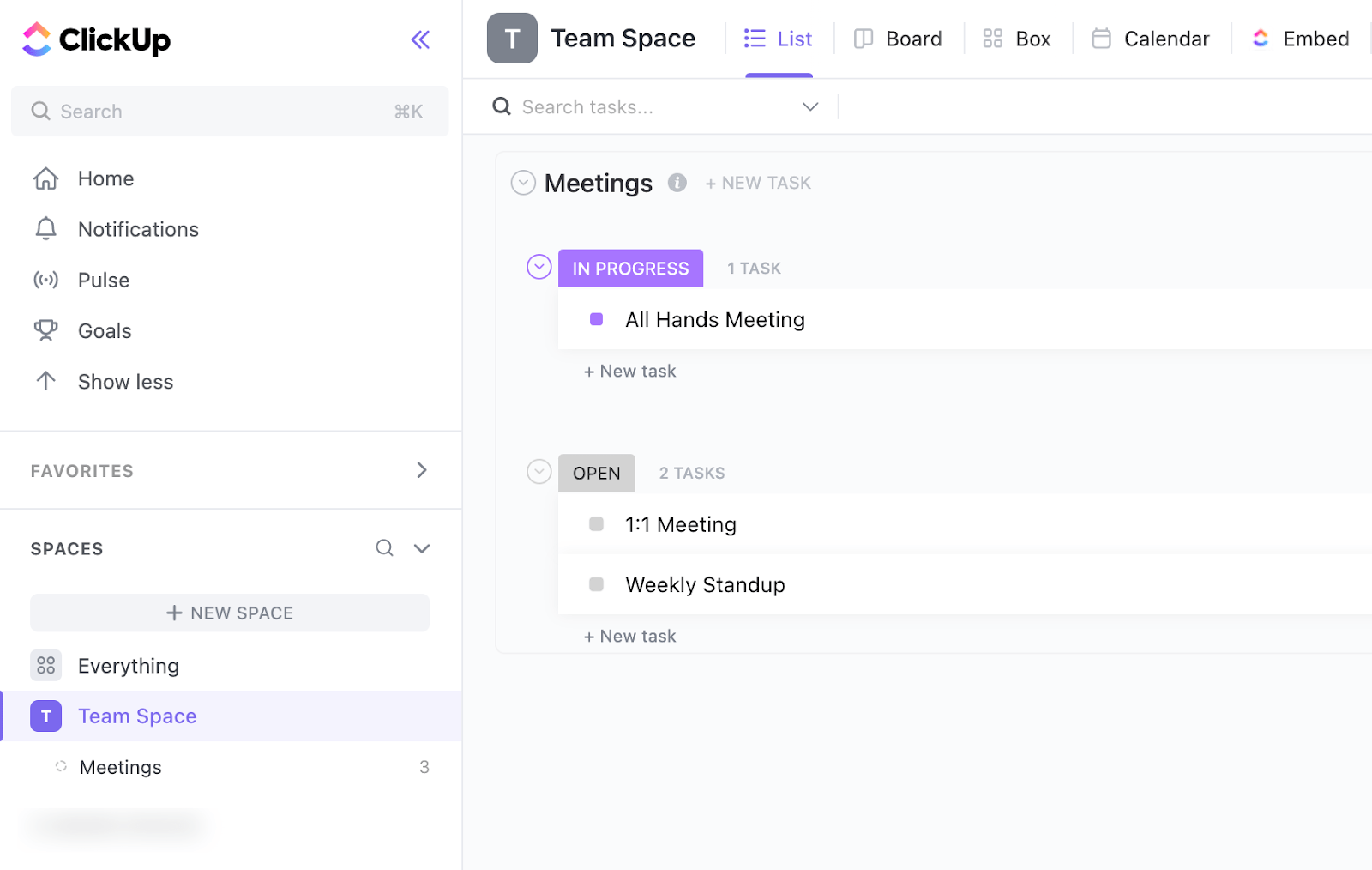
Holding project meetings can be a daunting task for many project managers. What you need is a foolproof solution: A project management platform with a wide range of features to make your meetings impactful and let you organize, plan, and document them well.
But first, let’s explore ten key project meetings that form the backbone of effective project management.
This meeting gathers the project team, stakeholders, sponsors, and other relevant individuals to officially launch the project. Its primary purpose is to align everyone with the project’s direction and secure the project sponsors’ and stakeholders’ buy-in.
Project status meetings, AKA status reviews, are regular check-ins to review project progress, address obstacles, align team members, and make necessary adjustments.
Change control board meetings are held to review change requests to the project scope, deliverables, timelines, or budget. A change control board reviews the proposed changes; evaluates their impact; decides whether to approve, reject, or modify them; and ensures that changes are made in a controlled and coordinated manner.
Sprint planning meetings are specifically used in agile project management methodologies. It involves the Scrum master, the Scrum product manager, and the Scrum team. These meetings happen at the start of each sprint, which is a defined period for completing specific objectives.
Daily Scrum meetings or stand-ups are brief 15-minute gatherings for the Scrum team to review progress, address impediments, and adapt their plans. It’s an essential forum to stay on track and make necessary adjustments after establishing the sprint plan.
During this meeting, each team member gives the team leader an update on the project status, their accomplishments from the previous day, the tasks planned for the day, and any challenges they may face.
Stakeholder meetings, also known as level-10 meetings, are scheduled to update key stakeholders (clients, investors, senior leadership) on project progress, gather their insights and goals, address concerns, and approve important decisions.
This is a company-wide meeting that brings together everyone to discuss matters relevant to the entire organization. For projects, these meetings are held to convey important updates, share success stories, encourage team building, and keep the team engaged.
One-on-one meetings go by various names, such as check-ins or 1:1s. These are regular meetings between a manager and a team member to discuss work, career development, and personal matters.
One-on-one meetings are vital for building trust, providing feedback, and ensuring employee engagement.
Contingency planning meetings are crucial for organizations to proactively prepare for and respond to potential risks or disruptions that could hinder operations.
These meetings bring together key stakeholders to identify potential threats, assess their likelihood and impact, and develop strategies to mitigate or manage them effectively.
Project review meetings are a crucial aspect of project management. These meetings are held at specific points in the project lifecycle to evaluate its progress, assess risks, and make strategic decisions. These meetings are usually scheduled after major milestones, before key events, or following significant changes.
Now that you have a comprehensive understanding of key project meetings and their purpose, you are ready to call for and run such meetings. But first, here are some tips to help you make the most of them!
Transform your project meetings into productive and engaging sessions with these essential strategies and tips for effective project management.
Given the rise of remote work, we will primarily discuss virtual meetings. Nevertheless, you can still employ most of these strategies in face-to-face interactions.
Here are some strategies and tips to help you facilitate a well-organized meeting.
Before you start a project or schedule any meeting, take some time to define the specific objectives you want to achieve.
What do you hope to accomplish with the meeting? What decisions do you need to make? What information do you need to share?
Having clear objectives will help ensure everyone is on the same page and focused on the task at hand.
To start your project with a strong foundation, Use ClickUp’s project kick-off meeting templates. Ensure your team adheres to the project objectives and timelines while minimizing risks.

Once you have the objectives in mind, create a detailed meeting agenda. The agenda should outline the topics that will be discussed, the person responsible for presenting the topics, and the amount of time allotted to each topic.
Distributing the agenda in advance will allow your team members to come prepared and participate actively.

Include only those individuals who are directly involved with the meeting’s agenda items. You can use Jeff Bezos’ famous two-pizza rule to guide you: it suggests that the maximum number of members for a productive meeting is the number that could be fed with two pizzas. Limiting the attendees ensures everyone’s time is valued and they are focused on the task at hand.
Starting and ending meetings on time demonstrates respect for schedules and helps maintain focus throughout the session. If you need to discuss a topic in a status meeting but it’s stretching over the scheduled slot, consider scheduling a follow-up meeting to avoid derailing the current one.

Create a collaborative environment that encourages team members to participate and boosts engagement. Ensure everyone’s voices are heard and acknowledge different perspectives and opinions. This fosters a culture of open communication.

In larger meetings, consider assigning specific roles to participants, such as a facilitator, note-taker, and timekeeper. Delegating tasks helps maintain structure, keeps the discussion on track, and ensures everyone plays a part.
Document all discussions, including those that deviate from the original agenda, assignments made, decisions reached, and any updates provided. Use AI-powered note-taking tools to record important decisions and action items easily. Meeting notes templates are also helpful for sharing notes with the team.


Conclude the meeting by taking meeting notes and summarizing key takeaways, decisions, and action items. Clearly define who is responsible for each action item, set deadlines to complete tasks, and establish a follow-up mechanism to maintain accountability.

Share meeting minutes with key takeaways, action items, and any decisions made. Record meetings and share video clips of meetings to provide context and help your team implement the action items.
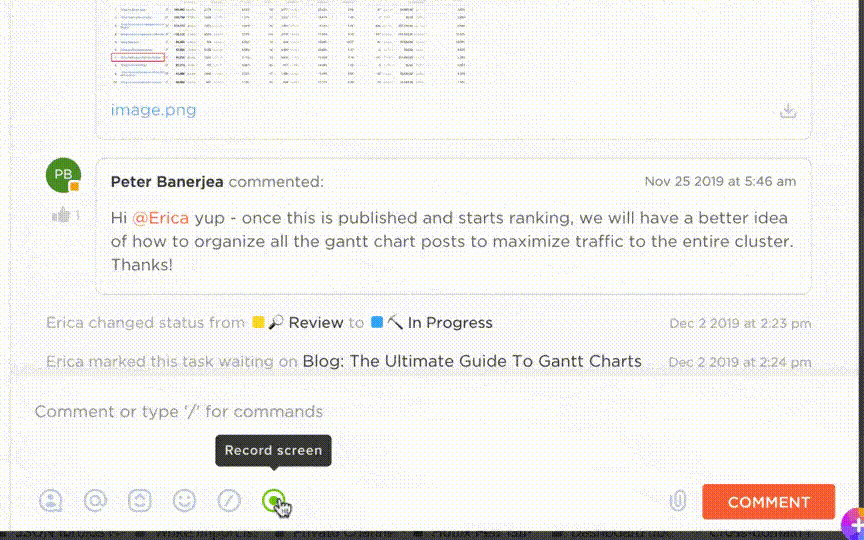
Advancements in technology, especially AI, have been the greatest balm to project management headaches.
AI tools for meetings automate mundane and repetitive tasks so your team can focus on the most important parts of a meeting, discussion, and collaboration.
Use online meeting tools and collaborative document sharing to enhance the meeting experience. These tools streamline communication, facilitate information sharing, and provide a centralized repository for documentation and action items.
Now that you’re armed with strategies to manage current and upcoming meetings more effectively, let’s look at templates—to jumpstart the project planning process and provide consistency across project meetings.
Project management templates are pre-formatted documents or tools that provide a standardized framework for organizing, tracking, and communicating project information. A project manager can use these templates to structure and execute productive, focused meetings that drive results.
From defining the meeting agenda and goals to tracking key performance indicators and action items, templates can help you make every meeting a strategic success.
Templates offer several benefits to enhance a project meeting: They provide structure and guidance, enforce consistency, ensure efficiency, improve decision-making, and make communication effective.
These templates, like the 1-on-1 meeting template, can be used by project managers and meeting attendees alike to standardize and improve their work across projects.
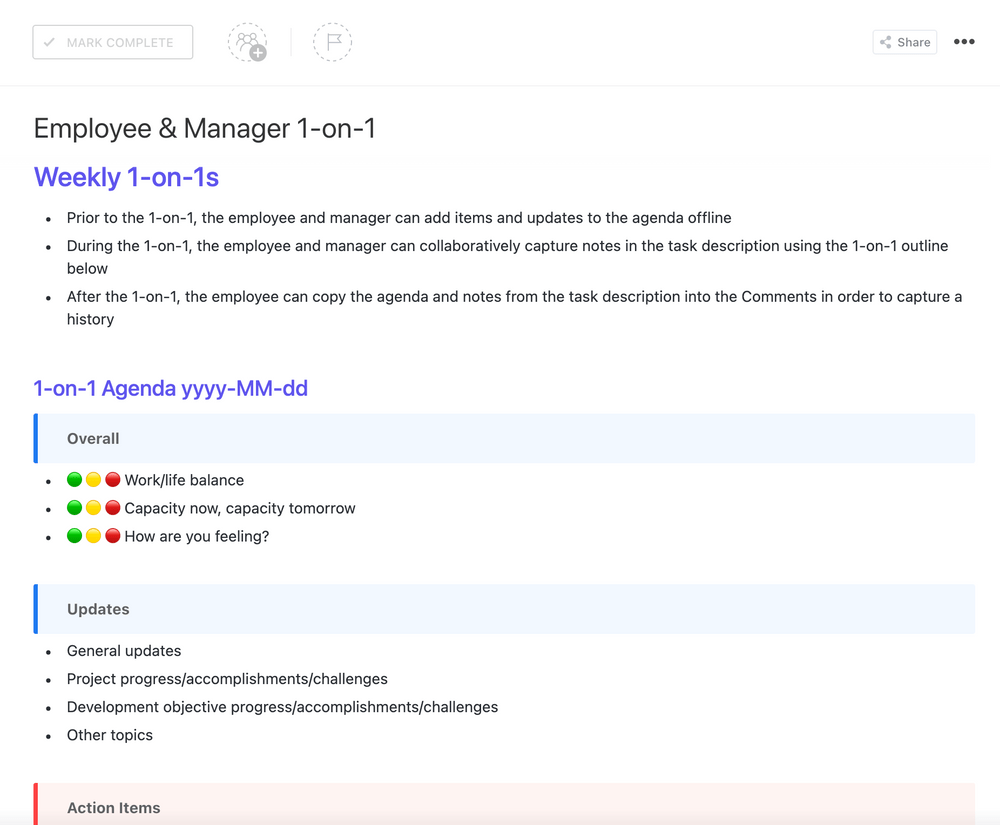
ClickUp’s template directory provides you with templates for several project management scenarios. You can even go a step further and create, customize, and share templates with your team members to standardize data across project management activities.
We’re sure you’ve guessed this by now! ClickUp is an all-in-one productivity platform designed to help you achieve the desired outcomes from your meetings and projects.
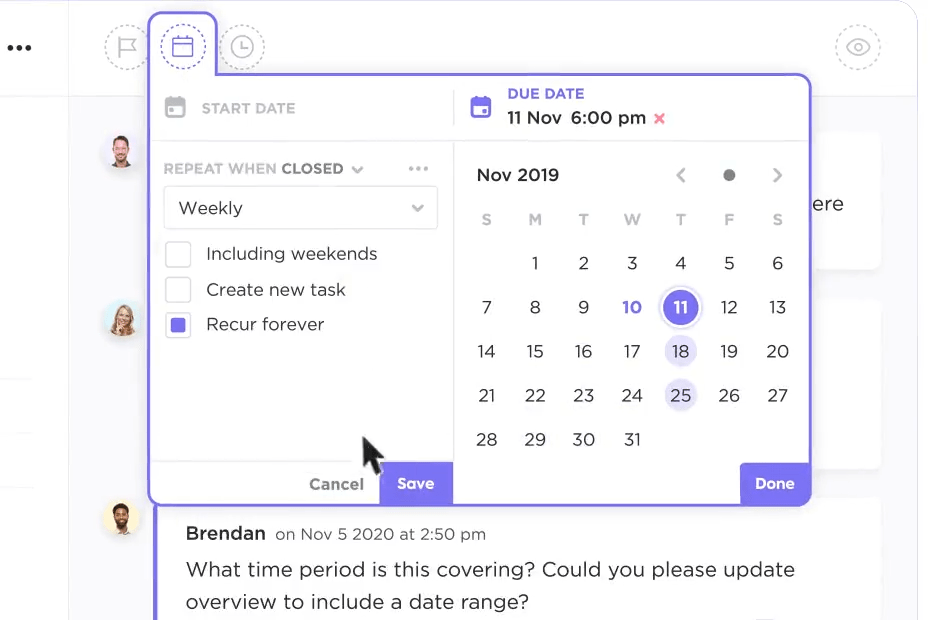
Additionally, a centralized location to capture agenda items, notes, and action items ensures nothing slips through the cracks. Let ClickUp’s recurring task functionality automatically schedule regular meetings and set follow-up reminders for you and your team.
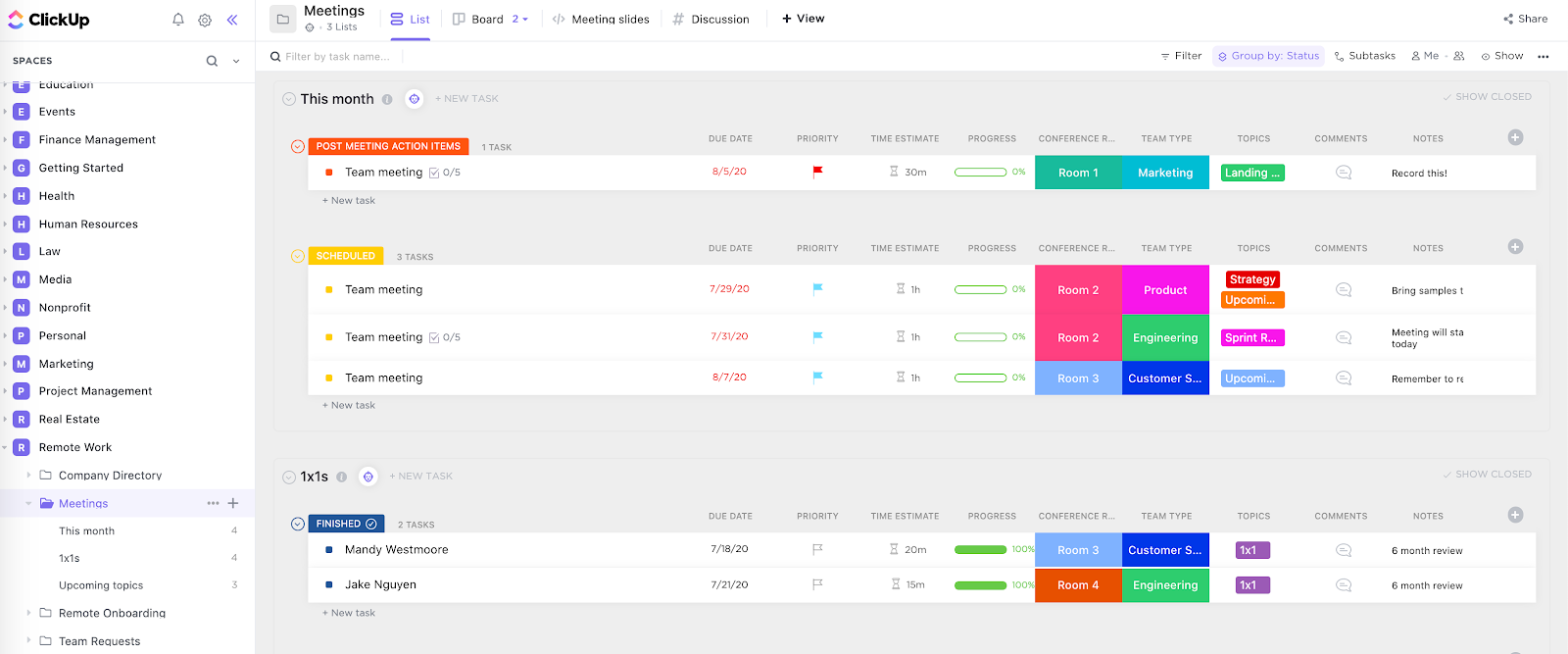
Mastering project meetings is a great skill to have, but tying it all to broader project management activities is another challenge.
ClickUp promises to solve this and offers a comprehensive project management software platform that integrates project meetings into your workflows.
A centralized hub for managing all aspects of your project, ClickUp assists you in planning, execution, communication, and documentation, too.
Experience the transformative power of ClickUp for your project management needs.
There are many types of project meetings, depending on their purpose, format, and formality. Some of those are project team meetings, project status meetings, stakeholder meetings, project workshops, and governance meetings.
ClickUp provides a comprehensive suite of project management tools, including features for managing meetings. With ClickUp, you can summarize meeting notes, collaborate using tools like Docs, Clips, and Notepad, and streamline your meetings with a wide selection of templates.
Some of the best strategies to improve the effectiveness of project meetings are to define objectives, create agendas, include the right participants, start and end meetings on time, encourage active participation, assign specific meeting roles, take notes and summarize key points, assign action items, use technology, and seek feedback and adapt.
© 2025 ClickUp